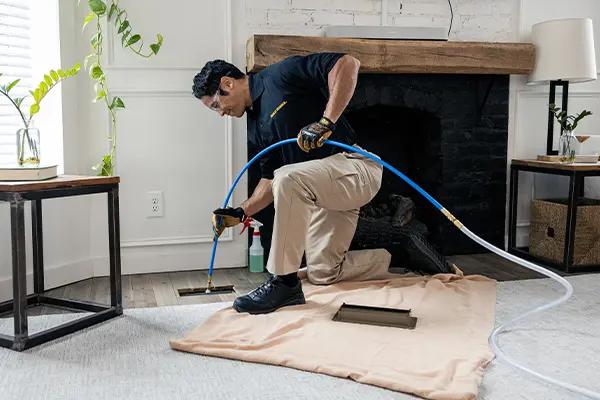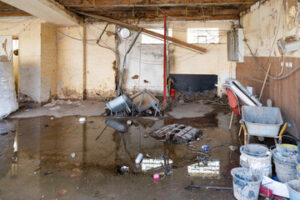It’s a good idea to tidy up so that your technician has easy access to your vents and HVAC equipment. You’ll also want to be home so that you can greet them and show them where the vents are located.
Air Duct Cleaning Salt Lake City uses specialized equipment to remove dirt, dust, and debris from your ductwork system. The process uses negative pressure to dislodge particles and a truck-powered vacuum to suck them away.

Before cleaning the ducts, you should first do a visual inspection. Remove the vent covers in each room and look inside for mold, rodent droppings, or other debris that might indicate a problem with the ductwork. You can also find out if your air ducts need cleaning by noticing drafty rooms, extreme temperature variations between rooms, and musty odors. If your ducts are located in uninsulated spaces like attics and crawlspaces, they can be particularly susceptible to leakage, which wastes energy and may even pose a carbon monoxide danger.
If your ductwork is exposed, you should feel along seams and joints and listen for whistling noises. A reputable duct cleaner will use the National Air Duct Cleaning Association (NADCA) standard cleaning methods to clean your ducts, registers, filters, plenums, evaporator coils, and air handlers.
Leaks are the most common reason for ductwork to need cleaning. You can test for them by holding a smoke stick, incense, or piece of paper up to your ductwork connections and joints. If the smoke or paper moves erratically, you have a duct leak that a professional should repair.
Another reason to get your ducts cleaned is animal dander, which can build up and circulate throughout the home. This contaminates indoor air, aggravating respiratory conditions and exacerbating allergy symptoms. It can also circulate after a fire or flood, leaving behind contaminants that can worsen the effects of smoke and water damage.
A duct cleaning company will use brushes and other agitation devices to loosen the dust and dirt accumulated in the ducts over time. Then, a truck-powered vacuum can remove this material from the ducts and dispose of it properly.
Lastly, the ducts should be inspected again to ensure the cleaning process has caused no problems. If the ductwork leaks, you must have it sealed by a professional. This step will ensure the contaminated air does not recirculate and pollute your home again. If your ductwork is sealed correctly, your home’s indoor air quality will improve drastically, and you can avoid the health complications that are associated with poor indoor air quality.
Clean air is vital to the health and comfort of everyone in your home. Air ducts containing pet dander, dust, dirt, mold spores, mildew, and other contaminants can cause allergy attacks or exacerbate conditions like asthma, bronchitis, and other respiratory issues. The toxins may also circulate throughout the house and trigger foul odors. Air ducts should be cleaned regularly to reduce the need for repairs, sick time, doctor visits, hospital bills, and other costs associated with poor indoor air quality.
A professional service provider will use a variety of brushes and tools to dislodge contaminants. This is usually accompanied by vacuums that suck up the debris and dust. This is the most thorough method and can be expensive, but it provides a complete clean. It is recommended that this type of cleaning be done every five years or so.
Once the ducts have been agitated and vacuumed, they should be visually inspected for any debris that is left behind. This will help to determine the next step of the cleaning process. The service provider should note any areas with a lingering smell, as this could indicate the presence of mold or other contaminants. Some service providers will recommend applying chemical biocides to encapsulate or kill microbiological contaminants. It is important to remember that these chemicals should only be used after the ducts have been thoroughly cleaned of all visible pollutants.
Depending on the size of your home, you may need to have a few different air ducts cleaned. The air ducts that lead to your return and supply vents are typically the most heavily contaminated. A simple test to see which ducts are return or supply ducts is to put a tissue on the vent opening. If the tissue sticks, it is a return duct; if it blows off, it is a supply duct.
The cleaning process will also include your air handler and plenums, so ensure you have a clear path to these units. This may involve moving furniture out of the way and can take some time. It is recommended that you plan for the duct cleaners to work when your family will not be disturbed. You should prepare for your baby’s naptime or your Zoom meeting to be held at another location during the day of your appointment.
Air is pulled into your home through the HVAC system, then recirculated on average 5 to 7 times daily. That re-circulation brings in dust, allergens, and pollutants from the outside environment. When the evaporator coils in an air conditioning unit are dirty, they use more energy to cool your home and have a shorter lifespan than clean coils. Annual cleaning of the air handler and evaporator coils can reduce the energy used by your HVAC system, save money on your energy bills, and improve indoor air quality.
An air duct cleaning service will use professional equipment to remove contaminants from your air handler’s evaporator coils, blower motor, and drain pan. Depending on the service provider and your home, they may also clean the registers, grilles, fans, and the HVAC unit itself. They will typically begin by removing the cover and evaporator coils and vacuuming as needed to remove any loose particles from the surface.
Then, they will agitate all the surfaces in your air handler with brushes and air-whipping tools to stir up and move any remaining settled dust. Next, they will use the vacuum collection device to suck out the loosened debris into the collection container. Once the ductwork and air handler are cleaned, they should re-test your HVAC system. This test, called a blower door test, creates reverse pressure in the house and makes leaks easier to identify.
A reputable air duct cleaning company should take between three and five hours to perform an air duct cleaning. If a contractor claims they can do it in less time, they are likely taking shortcuts and just cleaning what you can see. A reputable company should thoroughly clean all the ductwork, including the vents, AC units, and other hidden components. They should also perform a blower door test after they finish and provide you with a written report of their findings. Be sure to clear a path to your air handler and ducts, and keep children and pets out of the way during the process. The noise and movement could scare them.
A dirty duct system can contain animal dander, pollen, dust, mildew, and other allergens. These toxins are circulated throughout the house, aggravating existing allergies or asthma and creating new ones. These toxins are also a perfect breeding ground for bacteria, germs, and other types of fungi. Dirty air ducts are a major cause of year-round respiratory problems in many people, especially those with asthma or allergies.
Duct cleaning removes these contaminants and allows the clean air to flow through your home. Clean ducts reduce respiratory symptoms in people who suffer from these conditions, making breathing easier for everyone. Dirty air can trigger sneezing, coughing, and sinus congestion, even for those without respiratory conditions.
Several methods are used to clean air ducts, but the best is a compressed air system that uses an air compressor with a special hose and nozzle. This tool forces compressed air through the duct and into the vents, dislodging dirt and debris and sending it into a collection bag. Another option is a vacuum that works similarly. Both of these tools are effective and safe to use, but they aren’t a substitute for an inspection by a professional.
Before beginning a duct cleaning, locating the supply vents is important. This is usually easy; the vent will be a straight run for a short distance, then turn in two opposite 90-degree directions (known as a tee). It’s helpful to have a flashlight handy when looking inside the duct, and it helps to know which direction the tee is facing.
Once the tee is identified, start at one of the supply vents and push in the cleaning head until it reaches the end of the duct. This may take some effort, and you’ll want to be careful not to puncture the duct, but don’t be afraid to push hard. When the cleaning head reaches the end of the duct, pull it out and move to the next vent. Repeat the process until all of the ducts are cleaned.

